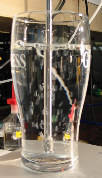

Quicktime movie (1.9 MB) AVI movie (2.2 MB)


Quicktime movie (2.8 MB) AVI movie (1.8 MB)

Quicktime movie (2.4 MB) AVI movie (1.9 MB)
 |
No, it can happen in any liquid. There are a number of things about Guinness that make it easier to see though. Firstly, the bubbles produced are small, making them more easily pushed around by flowing liquid. The bubbles are small because they have been released at high pressure through fine holes (when poured from the tap or from the "widget"). The gas in the bubbles is also important. The fizz in most lager-beers (and soda) is carbon dioxide, which is more easily dissolved into the liquid. This is why you can see streamers of bubbles appear to form out of nowhere at the side of a glass of beer or cola: the dissolved carbon dioxide undissolves to form bubbles at tiny defects in the glass surface: they continue to grow, ingesting more dissolved carbon dioxide as they go up (as shown, left, for cola). In Guinness, the gas is nitrogen (which makes up roughly three quarters of the air we breathe). Nitrogen does not dissolve as well in liquid as carbon dioxide, and so the bubbles do not grow like in lager or cola. Another factor is the contrast in the colours of the very dark liquid and the light cream bubbles in Guinness, making the waves and bubbles more obvious. |
 |
To prove downflow of bubbles
happens in other
liquids, we looked at other draught-flow beers (e.g.,
Boddingtons). The results are exactly the same as with
Guinness. In this clip (Boddingtons)
you see a similar downflow of the
bubbles. A bubble-free wave of liquid can be seen very clearly. Quicktime movie (1.9 MB) AVI movie (2.2 MB) |
 |
Not being content with beer, we set
out to make bubbles go down in other liquids. To do this we
devised a "bubble-maker", as shown in the picture opposite. This
is just a piece of tube with fine holes in the end (at the bottom)
through which we can blow gas to make small bubbles. The liquid
in the glass is just plain water.
The bubbles go up the center of
the glass, just like in the Guinness, and create a circular flow that
causes bubbles at the inside edge near the top to be pushed downwards.
You can see the result in the next clip below. |
 |
In this clip you can see the
bubbles produced at the top of the glass of water by
the bubble-maker. The
bubbles are much larger than are produced in Guinness. This is
because they have not been produced at high pressure as they have in
Guinness, a process known as "gas breakout".
Quicktime movie (2.8 MB) AVI movie (1.8 MB) |
 |
Another way of making bubbles go
down is to simply add a fizzing tablet
to a glass of water.
These
are not so easily seen with the eye, but easily seen with the fast
camera: as shown in the clip here. Another way of visualizing the
flow is to use a suspension of powder in liquid giving what is known as
a rheoscopic
fluid. The particles of the additive powder allow the fluid flows
to be visualised. Bottles of rheoscopic fluids can be purchased
at good science or teacher supply stores.
Quicktime movie (2.4 MB) AVI movie (1.9 MB) |